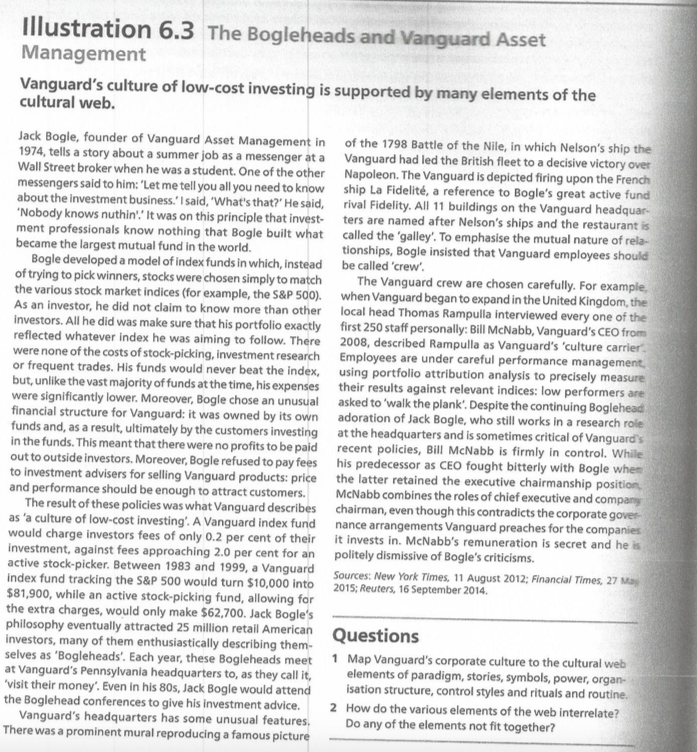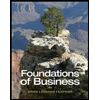Illustration 6.3 The Bogleheads and Vanguard Asset Management Vanguard's culture of low-cost investing is supported by many elements of the cultural web. Jack Bogle, founder of Vanguard Asset Management in of the 1798 Battle of the Nile, in which Nelson's ship the 1974, tells a story about a summer job as a messenger at a Vanguard had led the British fleet to a decisive victory over Wall Street broker when he was a student. One of the other Napoleon. The Vanguard is depicted firing upon the French messengers said to him: "Let me tell you all you need to know ship La Fidelité, a reference to Bogle's great active fund about the investment business. I said, "What's that?' He said, rival Fidelity. All 11 buildings on the Vanguard headquar- "Nobody knows nuthin'.' It was on this principle that invest- ters are named after Nelson's ships and the restaurant is ment professionals know nothing that Bogle built what called the 'galley'. To emphasise the mutual nature of rela- became the largest mutual fund in the world. Bogle developed a model of index funds in which, instead be called 'crew'. of trying to pick winners, stocks were chosen simply to match the various stock market indices (for example, the S&P 500). when Vanguard began to expand in the United Kingdom, the As an investor, he did not claim to know more than other local head Thomas Rampulla interviewed every one of the investors. All he did was make sure that his portfolio exactly first 250 staff personally: Bill McNabb, Vanguard's CEO from reflected whatever index he was aiming to follow. There 2008, described Rampulla as Vanguard's 'culture carrier. were none of the costs of stock-picking, investment research Employees are under careful performance management, or frequent trades. His funds would never beat the index, using portfolio attribution analysis to precisely measure but, unlike the vast majority of funds at the time, his expenses their results against relevant indices: low performers are were significantly lower. Moreover, Bogle chose an unusual asked to 'walk the plank'. Despite the continuing Boglehead financial structure for Vanguard: it was owned by its own adoration of Jack Bogle, who still works in a research role funds and, as a result, ultimately by the customers investing at the headquarters and is sometimes critical of Vanguard's in the funds. This meant that there were no profits to be paid recent policies, Bill McNabb is firmly in control. While out to outside investors. Moreover, Bogle refused to pay fees his predecessor as CEO fought bitterly with Bogle when to investment advisers for selling Vanguard products: price the latter retained the executive chairmanship position and performance should be enough to attract customers. The result of these policies was what Vanguard describes chairman, even though this contradicts the corporate gover as 'a culture of low-cost investing'. A Vanguard index fund nance arrangements Vanguard preaches for the companies would charge investors fees of only 0.2 per cent of their it invests in. McNabb's remuneration is secret and he is investment, against fees approaching 2.0 per cent for an politely dismissive of Bogle's criticisms. active stock-picker. Between 1983 and 1999, a Vanguard Sources: New York Times, 11 August 2012; Financial Times, 27 Ma index fund tracking the S&P 500 would turn $10,000 into 2015; Reuters, 16 September 2014. $81,900, while an active stock-picking fund, allowing for the extra charges, would only make $62,700. Jack Bogle's philosophy eventually attracted 25 million retail American Questions investors, many of them enthusiastically describing them- selves as 'Bogleheads'. Each year, these Bogleheads meet 1 Map Vanguard's corporate culture to the cultural web at Vanguard's Pennsylvania headquarters to, as they call it, 'visit their money'. Even in his 80s, Jack Bogle would attend the Boglehead conferences to give his investment advice. Vanguard's headquarters has some unusual features. There was a prominent mural reproducing a famous picture tionships, Bogle insisted that Vanguard employees should The Vanguard crew are chosen carefully. For example, McNabb combines the roles of chief executive and company elements of paradigm, stories, symbols, power, organ- isation structure, control styles and rituals and routine. 2 How do the various elements of the web interrelate? Do any of the elements not fit together?
Critical Path Method
The critical path is the longest succession of tasks that has to be successfully completed to conclude a project entirely. The tasks involved in the sequence are called critical activities, as any task getting delayed will result in the whole project getting delayed. To determine the time duration of a project, the critical path has to be identified. The critical path method or CPM is used by project managers to evaluate the least amount of time required to finish each task with the least amount of delay.
Cost Analysis
The entire idea of cost of production or definition of production cost is applied corresponding or we can say that it is related to investment or money cost. Money cost or investment refers to any money expenditure which the firm or supplier or producer undertakes in purchasing or hiring factor of production or factor services.
Inventory Management
Inventory management is the process or system of handling all the goods that an organization owns. In simpler terms, inventory management deals with how a company orders, stores, and uses its goods.
Project Management
Project Management is all about management and optimum utilization of the resources in the best possible manner to develop the software as per the requirement of the client. Here the Project refers to the development of software to meet the end objective of the client by providing the required product or service within a specified Period of time and ensuring high quality. This can be done by managing all the available resources. In short, it can be defined as an application of knowledge, skills, tools, and techniques to meet the objective of the Project. It is the duty of a Project Manager to achieve the objective of the Project as per the specifications given by the client.
Please help me with the 2 questions of this case study.

Trending now
This is a popular solution!
Step by step
Solved in 3 steps




